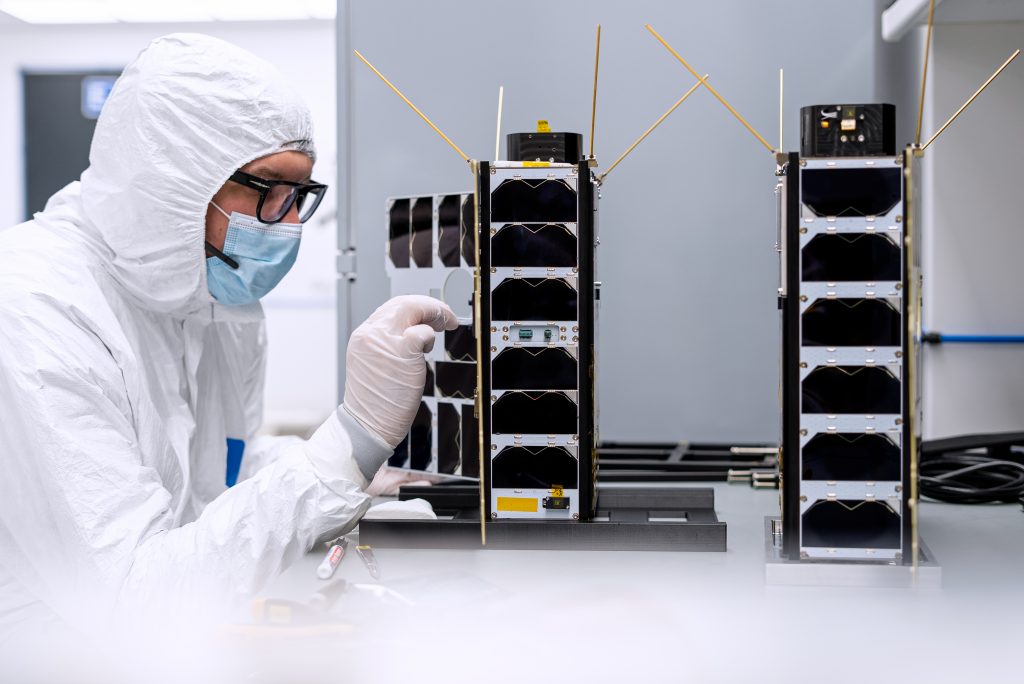- 2023-01-05
- The 6U nanosatellite and three others aboard the mission were built by Lithuanian smallsat mission integrator NanoAvionics
- NanoAvionics also announced the planned launch of its first 100+ kg microsatellite
Cover Image: Gama Alpha Solar Sail. Credits: Gama.
Kongsberg NanoAvionics (NanoAvionics) has announced the successful launch of Europe‘s first solar sail mission aboard SpaceX Transporter-6. The 6U nanosatellite nicknamed ‘Alpha’ was manufactured for France’s Gama. It is one of four satellites, built by the Lithuanian smallsat mission integrator for multiple customers, that got sent into low Earth Orbit.
It is the first time for NanoAvionics that one of its nanosatellite buses has carried a solar sail payload into space. A second solar sail mission, using a 12U nanosatellite bus by the company, will be NASA’s composite solar sail system (ACS3).
Vytenis J. Buzas, co-founder and CEO of NanoAvionics, said: “Solar sails are one of the future propulsion methods for small satellites exploring deep space. Being the first European company to integrate solar sails into satellite buses and test them while in orbit puts us in a unique position within the space industry.”
Also on board were two other 6U nanosatellites (‘Birkeland’ and ‘Huygens’) built by NanoAvionics for a consortium of Norwegian and Dutch research centres. The MilSpace2 mission is the first known two-satellite system to detect, classify, and accurately geolocate radio frequency signals. The two satellites will fly in formation at a close proximity of 20 kilometres.

The MilSpace2 mission is not the only application that can benefit from NanoAvionics bus capabilities to fly in swarms and operate as a single entity. This is an important feature for swarm missions ranging from remote sensing, to orbital reconnaissance for debris mitigation and other space infrastructure needs.
The fourth satellite carries an Earth observation payload for an undisclosed customer.
Confirming successful communications with all four satellites, NanoAvionics’s mission control centre continues executing the early operations phase (LEOP) to configure and validate the satellites for their primary mission objectives.

“With this first successful launch in 2023, NanoAvionics is off to a great start. We plan to deliver and launch more than 20 satellites to customers this year, up from 15 in 2022. This plan includes our first 100+ kg satellite based on our MP42 microsatellite bus,” Buzas said. “And for the third consecutive year, we nearly doubled both our revenue and our team size.”
Mission details for all Transporter-6 satellites built by NanoAvionics:
- A 6U nanosatellite dubbed “Alpha” for French space startup Gama to demonstrate their commercial solar sail with a diameter of 73.3 square meters (789 square feet) – roughly the size of a racquetball court. Gama’s range of solar sails are aimed at commercial companies and research organisations alike, looking for a cost-effective and less complex setup and propulsion system to explore deep space through small satellites. Using nano- or microsatellites propelled through space by solar sails would allow them to travel greater distances without storing large amount of fuel.
- Two 6U satellites named “Birkeland” and “Huygens”. Flying in close formation, the two satellites are part of The “Strategic Mutual Assistance in Research and Technology” (SMART) Military Use of Space (MilSpace) Science & Technology cooperation is a bilateral agreement between the MoD of the Kingdom of The Netherlands and the MoD of the Kingdom of Norway. The project team, acting on behalf of the MoDs, consists of FFI from Norway and NLR and TNO from The Netherlands. It is the first known two-satellite system to detect, classify, and accurately geolocate Radio Frequency signals, including navigation radars used on ships, by combining the measurement angle of arrival (AoA) and time difference of arrival (TDOA). Simultaneous detection of pulsed radio signals by both satellites flying in tandem enables accurate geolocation during all weather conditions.
- The fourth satellite carries an Earth observation payload for an undisclosed customer.
Watch Transporter-6 Launch livestream NanoAvionics did from the studio together with our colleagues and customers:






